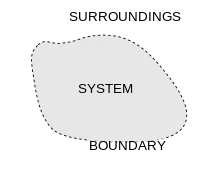Systems thinking
Systems thinking is a way of making sense of the complexity of the world by looking at it in terms of wholes and relationships rather than by splitting it down into its parts.[1][2] It has been used as a way of exploring and developing effective action in complex contexts,[3] enabling systems change.[4][5] Systems thinking draws on and contributes to systems theory and the system sciences.[6] See Dana Meadows, Thinking In Systems: A Primer[lower-alpha 1]

| Complex systems |
|---|
| Topics |
History
Ptolemaic system versus the Copernican system
The term system is polysemic: Robert Hooke (1674) used it in multiple senses, in his System of the World,[17]: p.24 but also in the sense of the Ptolemaic system versus the Copernican system[18]: 450 of the relation of the planets to the fixed stars[19] which are cataloged in Hipparchus and Ptolemy's Star catalog.[20] Hooke's claim was anwered in magisterial detail by Newton's (1687) Philosophiæ Naturalis Principia Mathematica, Book three, The System of the World[21]: Book three (that is, the system of the world is a physical system).[17]
Newton's approach, using dynamical systems continues to this day.[18] In brief, Newton's equations (a system of equations) have methods for their solution.
Feedback control systems

By 1824 the Carnot cycle presented an engineering challenge, which was how to maintain the operating temperatures of the hot and cold working fluids of the physical plant.[22] In 1868 James Clerk Maxwell presented a framework for, and a limited solution to the problem of controlling the rotational speed of a physical plant.[23] Maxwell's solution echoed James Watt's (1784) centrifugal moderator (denoted as element Q) for maintaining (but not enforcing) the constant speed of a physical plant (that is, Q represents a moderator, but not a governor, by Maxwell's definition).[24][lower-alpha 2]
Maxwell's approach, which linearized the equations of motion of the system, produced a tractable method of solution.[24]: 428–429 Norbert Wiener identified this approach as an influence on his studies of cybernetics[lower-alpha 3] during World War II[24] and Wiener even proposed treating some subsystems under investigation as black boxes.[28]: 242 Methods for solutions of the systems of equations then become the subject of study, as in feedback control systems, in stability theory, in constraint satisfaction problems, the unification algorithm, type inference, and so forth.
Bell system
- One policy, one system, universal service —Theodore Vail[29]
In 1876 Alexander Graham Bell patented the telephone and later founded Bell Telephone and its successors.[30][31]
The term universal service, came from Theodore Vail in 1907,[32] and has economic, legal and business ramifications including the communications systems of the Bell System.[33][34][29][31] The difficulties of reliably transmitting messages at continental scale required entire departments of the Bell system, and generations of technologies to overcome the problems.[35][30] [36]

By the Nyquist–Shannon sampling theorem, who were both employed by Bell, the sampling frequency must be 8 kHz for reasonable transmission of human voices.[38][37]
The bipolar junction transistor (1948). invented at Bell Laboratories, helped to usher in the integrated circuit, particularly by the invention of the self-aligned gate (1967).
The discovery of the cosmic microwave background occurred at Bell Laboratories and was awarded the Nobel prize in 1975.
Applications
- "So, how do we change the structure of systems to produce more of what we want and less of that which is undesirable? ... MIT’s Jay Forrester likes to say that the average manager can ... guess with great accuracy where to look for leverage points—places in the system where a small change could lead to a large shift in behavior".[39]: 146 — Dana Meadows, (2008) Thinking In Systems: A Primer p.146
Characteristics


- "...What is a system? A system is a set of things ... interconnected in such a way that they produce their own pattern of behavior over time. ... But the system’s response to these forces is characteristic of itself, and that response is seldom simple in the real world".—Dana Meadows[39]: 2
- Subsystems serve as part of a larger system, but each comprises a system in its own right. Each frequently can be described reductively, with properties obeying its own laws, such as Newton's System of the World, in which entire planets, stars, and their satellites can be treated, sometimes in a scientific way as dynamical systems, entirely mathematically, as demonstrated by Johannes Kepler's equation (1619) for the orbit of Mars before Newton's Principia appeared in 1687.
- Black boxes are subsystems whose operation can be characterized by their inputs and outputs, without regard to further detail.[39]: 87–88 [40]
- "system: (1) An integrated whole even though composed of diverse, interacting, specialized structures and subjunctions".[27]: 582
- Political systems were recognized as early as the millennia before the common era.[41][42]
- Biological systems were recognized in Aristotle's lagoon ca. 350 BCE.[43][44]
- Economic systems were recognized by 1776.[45]
- Social systems were recognized by the 19th and 20th centuries of the common era.[46][47]
- Radar systems were developed in World War II in subsystem fashion; they were made up of transmitter, receiver, power supply, and signal processing subsystems, to defend against airborne attacks.[48]
- Dynamical systems of ordinary differential equations were shown to exhibit stable behavior given a suitable Lyapunov control function by Aleksandr Lyapunov in 1892.[49]
- Thermodynamic systems were treated as early as the eighteenth century, in which it was discovered that heat could be created without limit, but that for closed systems, laws of thermodynamics could be formulated.[50] Ilya Prigogine (1980) has identified situations in which systems far from equilibrium can exhibit stable behavior;[51] once a Lyapunov function has been identified, future and past can be distinguished, and scientific activity can begin.[50]: 212–213
Systems far from equilibrium
Living systems are resilient,[12] and are far from equilibrium.[39]: Ch.3 [51] Homeostasis is the analog to equilibrium, for a living system; the concept was described in 1849, and the term was coined in 1926.[52][53]
Resilient systems are self-organizing;[12][lower-alpha 4][39]: Ch.3 [54]
The scope of functional controls is hierarchical, in a resilient system.[12][39]: Ch.3
Frameworks and methodologies
Frameworks and methodologies for systems thinking include:
- Critical systems heuristics:[55] in particular, there can be twelve boundary categories for the systems when organizing one's thinking and actions.[55]
- Critical systems thinking, including the E P I C approach.
- Ontology engineering of representation, formal naming and definition of categories, and the properties and the relations between concepts, data, and entities.
- Soft systems methodology, including the CATWOE approach, for example.
- Systemic design, for example using the double diamond approach.
- System dynamics of stocks, flows, and internal feedback loops.
- Viable system model: uses 5 subsystems 1 2 3 4 5.
Notes
- Dana Meadows, Thinking In Systems: A Primer[7][8] Overview, in video clips: Chapter 1[9] Chapter 2, part 1[10] Chapter 2, part 2[11] Chapter 3[12] Chapter 4[13] Chapter 5[14] Chapter 6[15] Chapter 7[16]
- A solution to the equations for a dynamical system can be afflicted by instability or oscillation.[25]: 7:33 The Governor: A corrective action against error can solve the dynamical equation by integrating the error.[25]: 29:44 [26]
- "cybernetics: see system science.";[27]: 135 "system science: —the systematized knowledge of systems"[27]: 583
- Abstract: "An inevitable prerequisite for this book, as implied by its title, is a presupposition that systems science is a legitimate field of scientific inquiry. It is self-evident that I, as the author of this book, consider this presupposition valid. Otherwise, clearly, I would not conceive of writing the book in the first place". —George J. Klir, "What Is Systems Science?" from Facets of Systems Science (1991)
References
- Anderson, Virginia, & Johnson, Lauren (1997). Systems Thinking Basics: From Concepts to Causal Loops. Waltham, Mass: Pegasus Comm., Inc.
- Magnus Ramage and Karen Shipp. 2009. Systems Thinkers. Springer.
- Introduction to Systems thinking. Report of GSE and GORS seminar. Civil Service Live. 3 July 2012. Government Office for Science.
- Sarah York, Rea Lavi, Yehudit Judy Dori, and MaryKay Orgill Applications of Systems Thinking in STEM Education J. Chem. Educ. 2019, 96, 12, 2742–2751 Publication Date:May 14, 2019 https://doi.org/10.1021/acs.jchemed.9b00261
- "School of System Change: Why Systems Change?". School of System Change: Learning to lead change in a complex world. Retrieved 2022-12-06.
- Systemic Thinking 101 Russell L Ackoff From Mechanistic to Systemic thinking, also awal street journal (2016) Systems Thinking Speech by Dr. Russell Ackoff 1:10:57
- Dana Meadows (1993) Thinking In Systems: A Primer
- Donella H. Meadows (1977) A Philosophical Look at System Dynamics 53:18
- Ashley Hodgson Thinking in Systems, Key Ideas (Ch. 1)
- Ashley Hodgson Thinking in Systems, Ch. 2: Types of System Dynamics 2a
- Ashley Hodgson Thinking in Systems, Ch. 2, Part 2: Limiting Factors in Systems 2b
- Ashley Hodgson Thinking in Systems, Ch. 3: Resilience, Self-Organization and Hierarchy 3
- Ashley Hodgson Thinking in Systems, Ch. 4: Why Systems Surprise Us 4
- Ashley Hodgson Thinking in Systems, Ch. 5: System Traps 5
- Ashley Hodgson Thinking in Systems, Ch. 6: Leverage Points in Systems 6
- Ashley Hodgson Thinking in Systems, Ch. 7: Living with Systems 7
- Hooke, Robert (1674) An attempt to prove the motion of the earth from observations
- J H Marchal (Dec 1975) On the concept of a system Philosophy of Science, Vol. 42, No. 4 (December 1975), pp. 448–468 (21 pages) as reprinted in Gerald Midgely (ed.) (2002) Systems thinking vol One
- Jon Voisey Universe Today (14 Oct 2022) Scholarly History of Ptolemy’s Star Catalog Index
- Jessica Lightfoot Greek, Roman, and Byzantine Studies 57 (2017) 935–9672017 Hipparchus Commentary On Aratus and Eudoxus
- Newton, Isaac (1687) Philosophiæ Naturalis Principia Mathematica
- Sadi Carnot (1824) Reflections on the Motive Power of Fire
- James Clerk Maxwell (1868) On Governors 12 pages
- Otto Mayr (1971) Maxwell and the Origins of Cybernetics Isis, Vol. 62, No. 4 (Winter, 1971), pp. 424-444 (21 pages)
- The Royal Society of Edinburgh (2016) Celebrating Maxwell's Genius and Legacy: Prof Rodolphe Sepulchre
- Karl Johan Åström and Richard M. Murray (2021) Feedback Systems: An Introduction for Scientists and Engineers, Second Edition
- IEEE (1972) Standard Dictionary of Electrical and Electronics Terms
- Peter Galison (1994) The Ontology of the Enemy: Norbert Wiener and the Cybernetic Vision Critical Inquiry, Vol. 21, No. 1 (Autumn, 1994), pp. 228–266 (39 pages) JSTOR
- David A. Mindell (2000) Opening Black's Box: Rethinking Feedback's Myth of Origin Technology and Culture, Vol. 41, No. 3 (July 2000), pp. 405–434 (30 pages)
- AT&T Tech Channel (2022) AT&T Archives: What is the Bell System?
- Matthew Lasar (3 September 2011) How AT&T Conquered The 20th Century Further reading
- AT&T (1876–2005) Milestones in AT&T history
- Hendrik Bode (September 1945) Network Analysis and Feedback Amplifier Design (originally mimeographed notes, published post-war)
- Frank B. Jewett, speech to National Academy of Sciences (April 1935) "Electrical communications: past, present, and future", reprinted in Bell Telephone Quarterly (July 1935) AT&T. pp.167–99, as cited by Mindell, 2000
- Garrett Fuller (16 Apr 2022) AT&T Long Lines – A Forgotten System
- 3rd page:The Bell Telephone Laboratory Series 27 titles For example, Network Analysis and Feedback Amplifier Design; Electrons and Holes In Semiconductors; Speech and Hearing in Communication
- CE Shannon "A Mathematical Theory of Communication" as reprinted in Gerald Midgley (ed.) (2002) Systems Thinking vol One
- Nyquist, Harry (April 1928). "Certain topics in telegraph transmission theory". Trans. AIEE. 47 (2): 617–644. Bibcode:1928TAIEE..47..617N. doi:10.1109/t-aiee.1928.5055024. Reprint as classic paper in: Proc. IEEE, Vol. 90, No. 2, Feb 2002 Archived 2013-09-26 at the Wayback Machine
- Dana Meadows, (2008) Thinking In Systems: A Primer
- Wiener, Norbert; Cybernetics: Or the Control and Communication in the Animal and the Machine, MIT Press, 1961, ISBN 0-262-73009-X, page xi
- Aristotle, Politics
- JS Maloy (2009) The Aristotelianism of Locke's Politics Journal of the History of Ideas, Vol. 70, No. 2 (April 2009), pp. 235–257 (23 pages)
- Aristotle, History of Animals
- Lennox, James (27 July 2011). "Aristotle's Biology". Stanford Encyclopedia of Philosophy. Stanford University. Retrieved 28 November 2014.
- Adam Smith (1776) The Wealth of Nations Book IV refers to commercial, and mercantile systems, as well as to systems of political enonomy
- Max Weber, The Protestant Ethic and the Spirit of Capitalism
- Talcott Parsons, The Structure of Social Action
- MIT Radiation Laboratory, MIT Radiation Laboratory Series, 28 volumes
- Richard Pates (2021) What is a Lyapunov function
- Prigogine, Ilya (1980). From Being To Becoming. Freeman. ISBN 0-7167-1107-9. 272 pages.
- Glansdorff, P., Prigogine, I. (1971). Thermodynamic Theory of Structure, Stability and Fluctuations, London: Wiley-Interscience ISBN 0-471-30280-5
- Cannon, W.B. (1932). The Wisdom of the Body. New York: W. W. Norton. pp. 177–201.
- Cannon, W. B. (1926). "Physiological regulation of normal states: some tentative postulates concerning biological homeostatics". In A. Pettit (ed.). A Charles Riches amis, ses collègues, ses élèves (in French). Paris: Les Éditions Médicales. p. 91.
- H T Odum (25 Nov 1988) Self-Organization, Transformity and Information Science Vol 242, Issue 4882 pp. 1132–1139 as reprinted by Gerald Midgley ed. (2002), Systems Thinking vol 2
- Werner Ulrich (originally 1987) A Brief Introduction to Critical Systems Heuristics (CSH)
Sources
- Russell L. Ackoff (1968) "General Systems Theory and Systems Research Contrasting Conceptions of Systems Science." in: Views on a General Systems Theory: Proceedings from the Second System Symposium, Mihajlo D. Mesarovic (ed.).
- A.C. Ehresmann, J.-P. Vanbremeersch (1987) Hierarchical evolutive systems: A mathematical model for complex systems" Bulletin of Mathematical Biology Volume 49, Issue 1, Pages 13–50
- NJTA Kramer & J de Smit (1977) Systems thinking: Concepts and Notions, Springer. 148 pages
- A. H. Louie (November 1983) "Categorical system theory" Bulletin of Mathematical Biology volume 45, pages 1047–1072
- DonellaMeadows.org Systems Thinking Resources
- Gerald Midgley (ed.) (2002) Systems Thinking, SAGE Publications. 4 volume set: 1,492 pages List of chapter titles
- Robert Rosen. (1958) “The Representation of Biological Systems from the Standpoint of the Theory of Categories". Bull. math. Biophys. 20, 317–342.
- Peter Senge, (1990) The Fifth Discipline